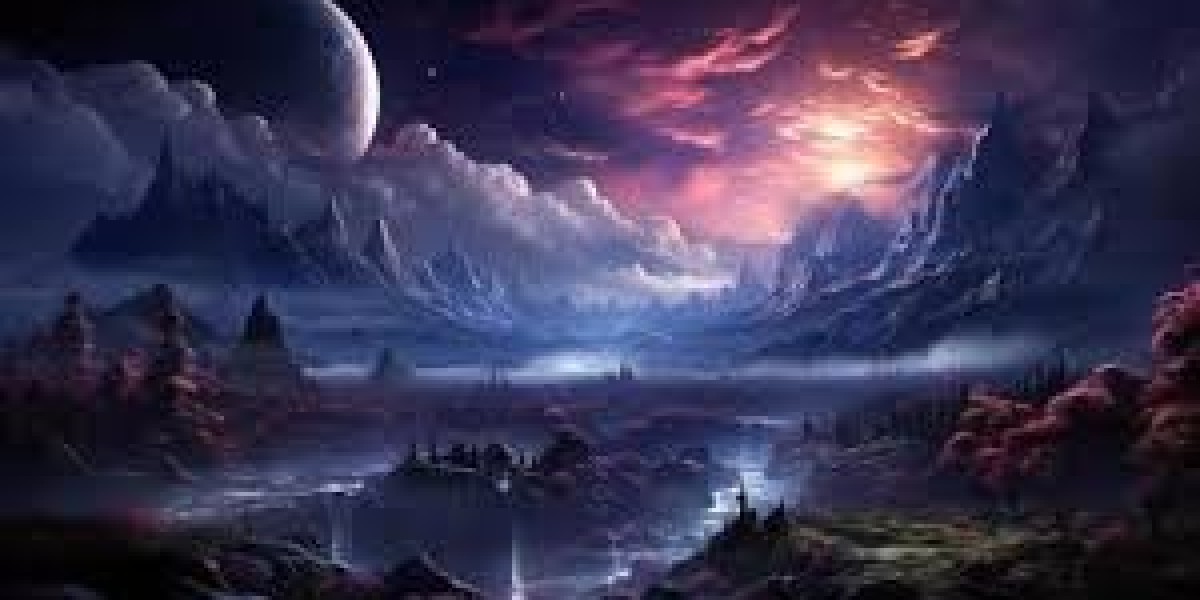Fantasy landscape art transports us to realms that exist only in the imagination, where towering mountains, mystical forests, and surreal skies evoke a sense of wonder and escape. These otherworldly landscapes often blend natural beauty with fantastical elements, creating environments that feel both familiar and dreamlike. From ancient mythologies to modern video games and movies, fantasy landscapes have played a crucial role in shaping our understanding of the unreal. In this article, we’ll explore the origins, characteristics, and significance of fantasy landscape art, as well as how it continues to inspire artists and audiences today.
The Origins of Fantasy Landscape Art
The roots of fantasy landscape art can be traced back to early human history, Fantasy character art where artists sought to convey the power and mystery of the natural world. Ancient civilizations often depicted grand, surreal landscapes in their artwork—think of the epic, otherworldly settings in the works of Greek and Roman mythology or the mysterious forests and mountains of Norse sagas.
However, it wasn’t until the Romantic period in the 18th and 19th centuries that the concept of fantasy landscapes, as we know them today, began to take shape. During this time, artists like Caspar David Friedrich and J. M. W. Turner created dreamlike, atmospheric landscapes that evoked powerful emotions. These paintings often blurred the line between reality and imagination, with sweeping skies and vast, untamed landscapes that seemed to stretch into infinity. While these landscapes were grounded in reality, they hinted at something beyond the visible world, setting the stage for more overtly fantastical depictions.
Key Characteristics of Fantasy Landscape Art
Otherworldly Atmosphere
One of the defining features of fantasy landscape art is the atmosphere. These scenes often feel distant, timeless, and sometimes even eerie. The use of exaggerated light, mysterious fog, or unusual color palettes helps create an ambiance that feels detached from the everyday world. These landscapes invite viewers to imagine themselves in a place beyond time or space, a place where the rules of reality do not apply.
Unusual Natural Elements
Fantasy landscapes frequently incorporate fantastical elements, such as floating islands, glowing rivers, or trees that seem to have minds of their own. These unusual features serve to make the landscape feel magical or otherworldly, allowing the viewer to experience a world unlike anything seen in real life. Many fantasy landscapes combine elements from different ecosystems—like desert sands meeting icy mountains or lush jungles juxtaposed with alien-like rock formations—creating a sense of wonder and discovery.
Surreal Architecture and Structures
In fantasy landscape art, architecture often plays a crucial role in setting the tone of the scene. Artists might create massive castles suspended in the sky, towering spires made of crystal, or ancient ruins that tell a story of forgotten civilizations. These fantastical structures are not just decorative; they imbue the landscape with a sense of mystery and narrative, prompting viewers to imagine the stories that lie hidden within these fantastical environments.
Otherworldly Lighting and Color Palettes
Light in fantasy landscape art often defies logic. Sunsets may stretch across entire horizons, casting long shadows that seem to move of their own accord. Creatures might glow with an ethereal light, or stars may shine brighter than anything seen in the real sky. The colors used are often bold, vibrant, or unnatural, such as purple skies, neon-green rivers, or silver trees, all designed to evoke a sense of awe and dreaminess.
Integration of Fantasy Creatures
Many fantasy landscape artworks feature creatures from myth, legend, or the artist’s own imagination. Dragons soaring through fiery skies, unicorns grazing in enchanted meadows, or vast herds of mystical beasts roaming the plains—all of these creatures enrich the narrative of the landscape. Their presence not only adds drama and life to the scene but also underscores the magical or surreal nature of the environment.
The Impact of Fantasy Landscape Art in Popular Culture
Fantasy landscape art has not only influenced the world of fine art but has also become a vital component of modern storytelling, particularly in films, video games, and literature. Iconic franchises like "The Lord of the Rings", "Avatar", and "Game of Thrones" rely heavily on fantastical landscapes to immerse audiences in their worlds. The breathtaking scenery in these films is often the result of a collaboration between concept artists, digital artists, and visual effects designers, all working to bring imaginative worlds to life.
In video games, fantasy landscapes are used to transport players to vast, interactive worlds. Games like the Elder Scrolls, Final Fantasy, and the Witcher series feature expansive, richly detailed environments that allow players to explore breathtaking mountains, magical forests, and dark dungeons. The freedom to navigate these fantastical landscapes has become a major draw for gamers, offering not just entertainment but an escape into alternate realities.
The Rise of Digital Fantasy Landscape Art
The rise of digital art has revolutionized fantasy landscape creation, opening up new possibilities for artists to push the boundaries of imagination. With tools like Photoshop, Blender, and various 3d modeling software, artists can create intricate, detailed landscapes that were once impossible to realize with traditional painting techniques. Digital art has enabled the blending of photo-realistic elements with fantastical ones, allowing for highly detailed, vivid landscapes that feel both familiar and fantastical.
Fantasy Landscape Art in Literature and Visual Storytelling
Writers have long used vivid descriptions of landscapes to establish mood and setting. In literature, authors like J. R. R. Tolkien, C. S. Lewis, and George R. R. Martin have created entire worlds with complex geographical features, from the towering mountains of Middle-earth to the frozen wastelands of Westeros. Their descriptive prose inspires artists to visualize and illustrate these settings, often resulting in stunning works of art that bring the worlds to life for readers and fans.
Fantasy Landscape Art in Contemporary Practice
Today, fantasy landscape art is more accessible than ever, thanks to the proliferation of digital media and online platforms. Artists are able to share their work with global audiences through websites, social media, and digital art marketplaces. Contemporary fantasy artists often blend elements from traditional painting, digital tools, and 3d rendering to create mesmerizing landscapes that can be viewed from any angle.
Platforms like DeviantArt and ArtStation showcase a wealth of fantasy landscape artwork, where artists can experiment with different styles, colors, and techniques. These online communities foster a sense of connection and collaboration, allowing fans to immerse themselves in the visual worlds created by talented artists from all over the globe.
The future of Fantasy Landscape Art
As technology continues to evolve, so too will the possibilities for creating fantasy landscapes. Virtual reality (VR) and augmented reality (AR) are already beginning to offer new ways to experience and interact with these imaginative worlds. VR allows users to step into a digital landscape and explore it firsthand, while AR might soon allow us to bring fantastical creatures or environments into our own reality, transforming how we experience fantasy art.
Additionally, the increasing use of artificial intelligence (AI) in creative fields is likely to give rise to new forms of landscape art, where AI-generated environments blend with human creativity. These advances will undoubtedly lead to even more fantastical, immersive experiences, pushing the boundaries of what we can imagine and creating new realms for us to explore.
Conclusion
Fantasy landscape art is more than just a genre; it is a gateway to the imagination, a way for artists and viewers alike to transcend the ordinary and experience the extraordinary. Whether through the sweeping vistas of a digital painting or the breathtaking scenes in a film, these fantastical worlds have the power to inspire, awe, and transport us to places beyond our wildest dreams. As technology continues to evolve, the future of fantasy landscape art promises to be even more immersive, pushing the limits of creativity and opening new frontiers for artistic exploration.


